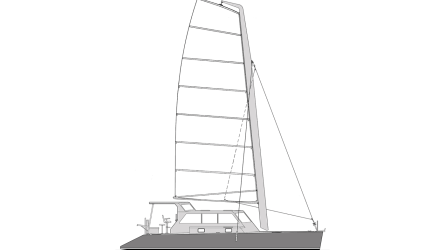Sights On A Delivery—Part One
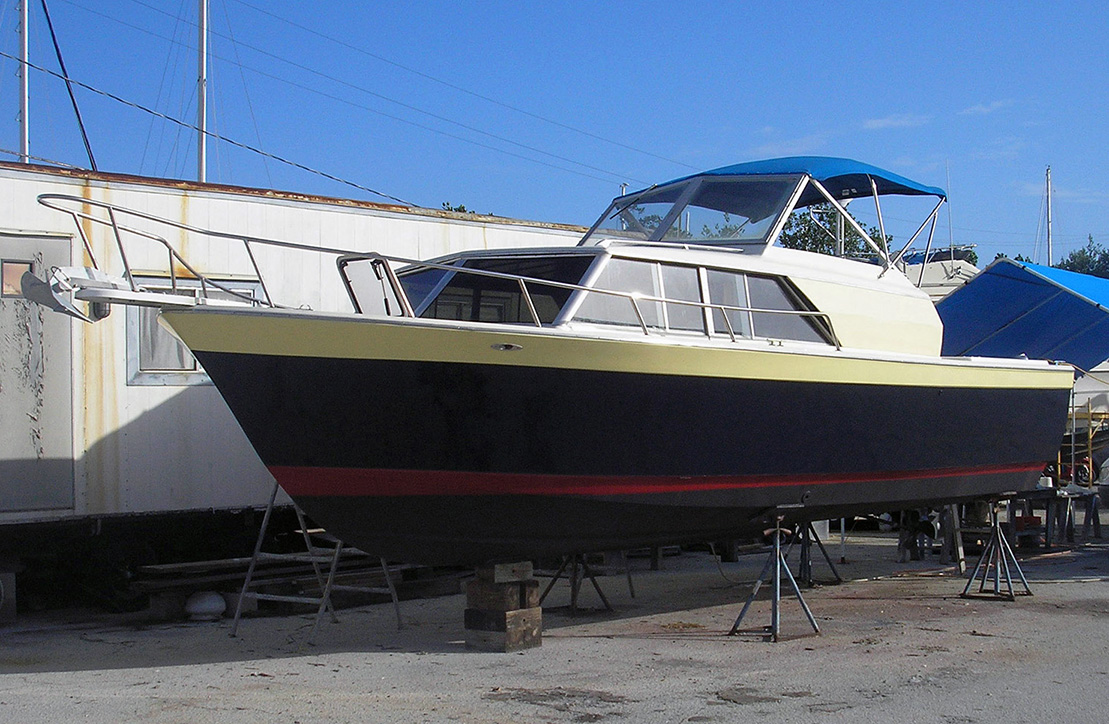
The restored 1965 Chris Craft Commander 27 J.B. just prior to being launched for the first time in a decade.
I spent the last two winters restoring a 1965 Chris Craft Commander 27 for Tony Bianco, an old and dear friend from New York. 1965 was only the second year for the “styled in fiberglass” Commanders. I usually have nothing to do with fiberglass boats, but Tony is getting old and needed a simple boat that would be as maintenance-free as possible. His first boat was a lapstrake Owens 24 cabin cruiser, and his fond memories of that boat prompted me to select the Commander for him.
Riverside Marina—the boatyard where I live and work half of each year—had a large selection of old boats to choose from. These were all “hurricane boats”—abandoned by their owners after the three major storms which devastated the Treasure Coast in 2004 and 2005. They were either hauled out just prior to the storms, or just after. Some had sunk, but most were just old and neglected.
I chose the Commander because it was single screw (all the others had twin engines), was simple (no flying bridge), was mostly intact, and had registration numbers. This last item would allow the previous owner to be traced (if possible), and would enable the boatyard to obtain a “rebuilt title” as the boat had been abandoned for ten years—with unpaid bills.
You can read about the restoration in Professional Boatbuilder #156, and about the delivery (Tony and I drove the Commander from south Florida to New York City) in the on-line version of Professional Boatbuilder. In this blog, I want to write about some of the sights we saw—particularly some interesting boats.
Passing us on its way south, we first saw a beautifully restored Huckins yacht in the Indian River. Huckins built early cold-molded wood powerboats, including PT boats during World War II. They were triple-diagonal-planked using mahogany and had sawn mahogany frames. I did a partial restoration on the Huckins TARGET II when I worked at the two Crackerboy Boatworks yards in Ft. Pierce and Riviera Beach, Florida, back in the early 1980s.
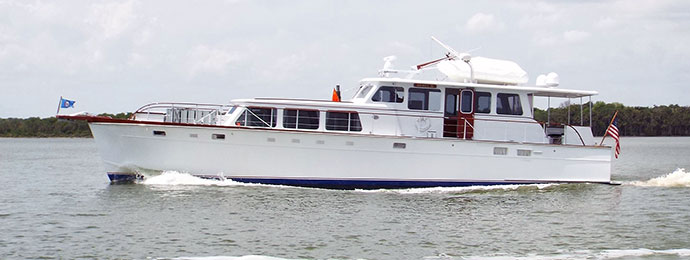
We passed this beautiful Huckins yacht in the Indian River, FL.
Next we passed a trawler-type yacht, which looked unusual enough that it may have been a custom one-off vessel, perhaps in cold-molded wood or even plank-on-frame. It appeared to be a very comfortable home, with outriggers for fishing (or anti-roll devices).

We passed this intriguing trawler-yacht in the ICW.
The next vessel of interest was a houseboat or office-boat. Houseboats interest me, partly because one of my best-selling designs is for the Sampan 36 houseboat, and partly because I have been thinking about building one for myself… although mine would be a floating office for Parker Marine. My living preference will always be a cruising sailboat.

A large, pragmatic-looking houseboat (office-boat?) we passed in the ICW
In southern Georgia we passed this classy looking yacht tied up at a marina where we stopped for fuel. She looked old, and wooden, and very expensive.
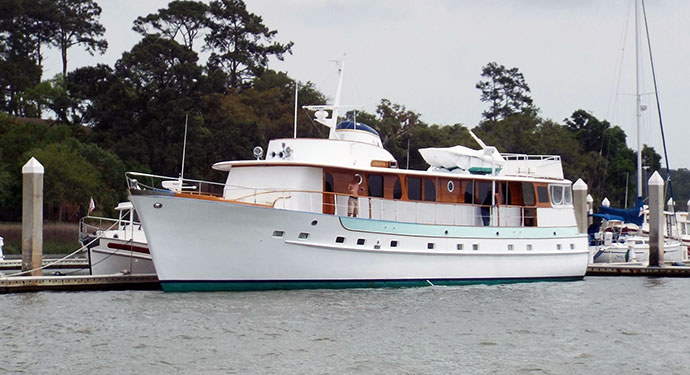
We passed this handsome yacht in Georgia.
One of my favorite stops on the migratory route is Beaufort, N.C., where my old pal Jeb is still dockmaster, and the Dock House still serves up burgers and ale. While leaving to continue north, we passed the excellent fishing vessel CAPT. STACY VII. She appeared to be cold-molded wood, but may have been plank-on-frame or even fiberglass. North Carolina is famous for high-quality commercial fishing boats—as well as sport fishing boats—and many are still built in wood.

The CAPT. STACY VII in Beaufort, N.C.
Another regular stop is Coinjock, VA, which used to have the cheapest fuel on the whole east coast (no longer true), and also boasts an excellent seafood restaurant. We spent a night there with the lovely wooden yacht BERNADETTE out of Newport, R.I., which I suspect may have been a Trumpy.
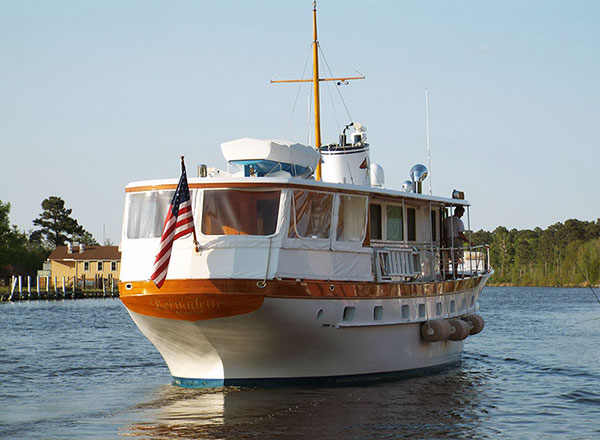
The lovely motor yacht BERNADETTE, in Coinjock, VA.
In the man-made canal between Albemarle Sound and Chesapeake Bay, I ran into a submerged tree, and caused severe damage to J.B.’s prop, strut and rudder. We hauled out for repairs at the venerable Atlantic Yacht Basin, and spent six days on the hard. AYB is famous for storing and working on vintage wooden power yachts (since 1936), and has several very large wet-storage covered sheds. While there, we saw an outboard-powered strip-planked center-console boat that I found very attractive.
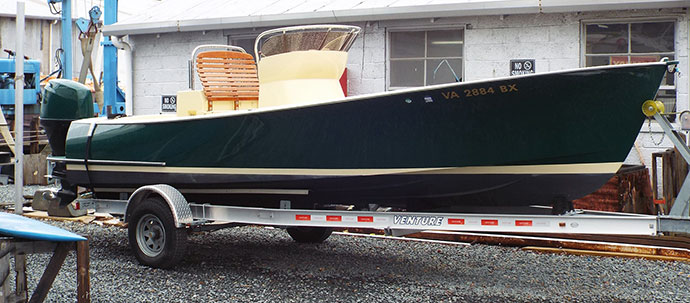
A beautiful strip-planked wooden runabout at Atlantic Yacht Basin, VA.
I have traversed the ICW (Intracoastal Waterway) more than 25 times, starting in 1981; but all those trips were in sailboats or motorsailers. I am used to motoring along at seven or eight knots, and rarely faster. The migratory lifestyle—sailing north in the spring and south in the fall—is not well suited to seasonal wind patterns. Large yachts and charter boats, with full crews, often run offshore in the Gulf Stream heading north, and heading south may run further east, out in the Atlantic. Clipper ships sailed from New York nearly out to the longitude of Bermuda, through the Windward Passage between Hispaniola and Cuba, around Cabo San Antonio, and north through the Gulf of Mexico to New Orleans. It was said that some could make this passage in ten days!
The reality for the small cruising sailboat, with one or two people on board, is that the prevailing winds are often contrary, and motoring in the ICW becomes the best option (sailing in the ICW is rarely feasible). Stopping at night, usually to anchor out, is the norm, and the migratory trip from Key West to Penobscot Bay can take as long as six weeks. I would make short hops outside, along the coast whenever possible, but to get in during daylight hours typically involved motorsailing.
Stopping to wait for bridges has always been another time-consuming nuisance, particularly as most bridges are timed (open on a schedule), and auxiliary sailboats frequently are not fast enough to get to the next bridge on schedule… and end up backing and filling for twenty minutes or more waiting for an opening. Very few things irk me more than this! One of the real joys of cruising the coast in J.B. was that she could pass under nearly all the bridges! J.B.’s height above water is less than eleven feet, and the only bridges that stopped her were for railroads (rarely down), and one pontoon bridge. This saved many hours of time on the whole delivery—perhaps even a full day.
Our speed was another major factor—although she has a top speed of over 25 knots, we ran J.B. at speeds between 13 and 17 knots to conserve fuel. This meant covering twice the distance each day over all my previous trips, and meant we could leave later and stop earlier when we wanted to.

A low bridge in the New Jersey ICW that J.B. effortlessly passed under.
In the New Jersey ICW, we passed through a canal town called Ventnor City, and were enthralled by the houses built right on the water, many on pilings. It looked to me to be a fun place to live—but my guess is it would not be cheap, even though some of the houses appeared very modest.
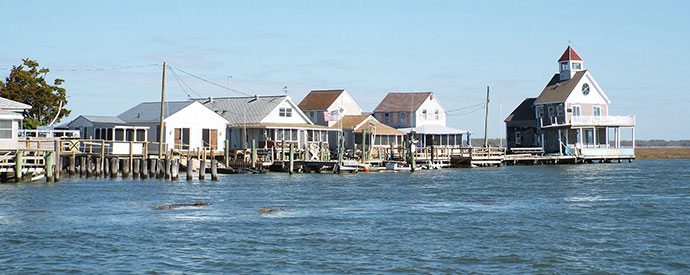
Canal houses in Ventnor City, N.J.
Our last stop before going to sea (the New Jersey ICW ends at Manasquan Inlet, 30 miles below Sandy Hook) for the short ocean passage to New York Harbor, was at a charming small place called the David Beaton Boatyard. We were given permission to stay overnight for free, and saw the following wooden lapstrake runabout. She was hanging in the slings in the water, presumably for her planking to swell.

The lapstrake runabout SHADOW, at the David Beaton Boatyard in N.J.
The yard also had a nice “yard dog”—a wooden work boat for maneuvering vessels and general work on the water. I love workboats, especially old wooden ones which look well-loved and well-used.

The excellent “yard dog” workboat at the David Beaton Boatyard.
The next day we arrived at Minneford’s on City Island, Bronx, N.Y.—another famous old boatyard—where Tony has a slip for J.B. The trip lasted twenty-three days, including six layover days (17 running days). I will save a description of New York Harbor and the East River for another blog.
June 10, 2015, Appleton, Maine
